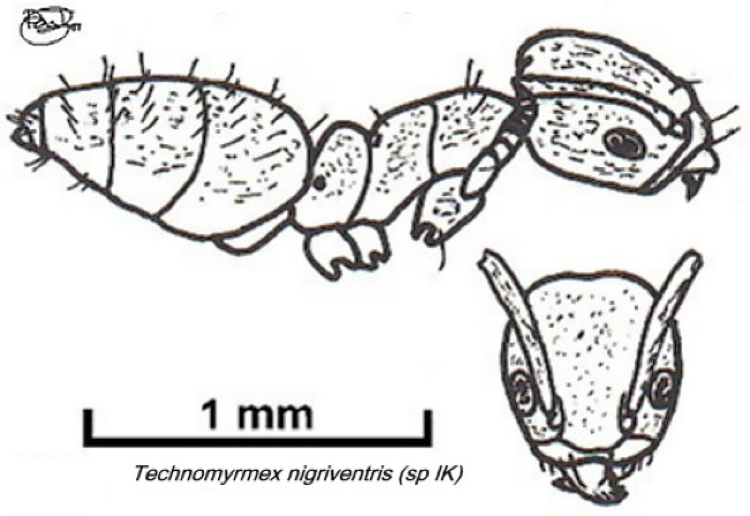Technomyrmex (Technomyrmex) nigriventris Santschi
  Type location Congo (Technomyrmex nigriventris n. sp.,
Santschi, in Forel, 1910f: 22, worker, as "Footnote" - Bolton, 1995) Type location Congo (Technomyrmex nigriventris n. sp.,
Santschi, in Forel, 1910f: 22, worker, as "Footnote" - Bolton, 1995)
worker only described (?) but males and females known (see Bolton,
1995; Wheeler, 1922)  . .
|
Note - Forel (1909b) listed the finding of Technomyrmex
nigriventris Santschi - a male and a female in Kinshasa by
Waelbroek, without any other information. Also, in his catalogue,
Wheeler (1922) had the authority as "Santschi, in Schultze, 1910; and
Santschi, 1910, Ann. Ent Soc. France, 78 (1909), 391";
and noted the sexual stages were reported but "without description" in
the "Santschi" Forel, 1909 report. Schultze (1910) was titled
'Forschungreise in Südafrika', IV; and he, L. Schultze collected albinasis
on Table Mountain, South Africa. All very confusing but Santschi
(1910c) simply listed the name, with a finding from Brazzaville, in
"parabiose" [cohabitation?] with Pheidole aurivillii Mayr
(Weiss)".
Santschi's (1910f) description, as a footnote, is on
page 22 of Forel (1910f), where the description of Technomyrmex
nigriventris Santschi subsp. albinasis
n. subsp. also appeared; these are both on  . Bolton's (2007: 30) re-description, not illustrated, is
at . Bolton's (2007: 30) re-description, not illustrated, is
at  . .
Arnold (1915: 149) provided a translation of - Santschi,
in Forel, Schultze Forschungreise Süd-Afr., footnote, p. 22,
1910. Type species.
"Worker - TL 2-2.8 mm. Pale testaceous yellow, the posterior region of
the head, and often the shoulders and dorsum of the thorax more or less
brownish, gaster black. The hairs on the thorax are scanty, fairly
short and yellow, they are longer and more abundant on the gaster and
around the mouth. The base of these hairs is often blackish. Pubescence
fine, yellowish and moderately abundant all over, slightly lessening
the shininess of the gaster.
Head and thorax sub-opaque. The whole body microscopically
reticulate-punctate. Mandibles smooth with a few piligerous punctures.
Head a little longer than wide, slightly narrowed in front, the
posterior angles rounded, the occipital margin feebly emarginate. The
eyes are longer than one-fourth of the sides of the head, their
anterior margins reaching the level of the antennal sockets. Clypeus
with a wide but shallow median longitudinal groove which ends
anteriorly in a distinct emargination. Mandibles with about a dozen
teeth, diminishing in size from the apical to the basal. The scape
reaches beyond the occiput by about the length of the 1st joint of the
funiculus, the median joints of the latter a little longer than wide.
The meso-metanotum is rounded posteriorly in an even curve as far as
the floor of the metanotal suture; the mesonotal spiracles do not
project above its profile. The profile of the propodeum almost
rectangular, with the dorsum about one-third the length of the
declivity; the latter flat and clearly margined.
Brazzaville, French Congo".
Santschi (1930a) noted this species has a similar colour
to T. semiruber but is distinguished by the absence of erect
pilosity on the appendages and a more matt sculpturation. He added the
finding of 4 workers at Luebo and Macaco, Zaïre, 1.x.1921, by
Schouteden. Wheeler (1922) noted - two workers taken by J. Bequaert at
Thysville, Zaïre, "beneath decaying leaves on the soil of a patch of
forest". Bernard (1952) reporting the Mt. Nimba, Guinea,
findings had several workers from N'Zo, and from the leaf litter
sampling in the north-eastern slope primary forest around 700 m
(Villiers). He felt the species might be very widespread in Africa
(noting the original locations) but it was small and secretive.
|
 Nigeria
specimens (as Technomyrmex
species species IK, Taylor, 1978: 55). WORKER. TL 2.05 mm, HL 0.59, HW
0.50, SL 0.51, PW 0.34 Nigeria
specimens (as Technomyrmex
species species IK, Taylor, 1978: 55). WORKER. TL 2.05 mm, HL 0.59, HW
0.50, SL 0.51, PW 0.34
Colour of head, alitrunk and appendages orange brown but gaster black,
shiny. Erect hairs sparse, most abundant on the gaster. Dense
pubescence all over. Propodeum humped with an acute, rounded apex.
Found by us at the Cocoa Research Institute of Nigeria, Idi Ayunre and
Apoje. Occasionally seen on cocoa, nests under bark and in debris
accumulations in tree forks.
As Technomyrmex species IK; in Taylor (1981) but
listed without reference by Bolton (2007).
This and the Congo worker shown below match the Santschi
type.
|